
The Hare's Ear or Gold Ribbed Hare’s Ear is a traditional artificial fly imitating an aquatic insect larva (nymph) used in fly fishing.

Fly tying is the process of producing an artificial fly used by fly fishing anglers to catch fish. Fly tying is a manual process done by a single individual using hand tools and a variety of natural and manmade materials that are attached to a hook. Although the recent history of fly tying dates from the middle 1800s, fly tyers were engaged in tying flys since at least 200 AD.

The Muddler Minnow is a popular and versatile artificial fly of the streamer type used in fly fishing and fly tying.

The Pheasant Tail nymph or PT Nymph or Sawyer's Pheasant Tail is a popular all purpose nymph imitation used by fly anglers. It imitates a large variety of olive, olive-brown colored aquatic insect larvae that many fish including trout and grayling feed upon.

The Clouser Deep Minnow is an artificial fly commonly categorized as a streamer and is fished under the water surface. It is a popular and widely used pattern for both freshwater and saltwater game fish and is generally listed as one of the top patterns to have in any fly box, especially for bass and saltwater flats fishing.

An artificial fly or fly lure is a type of fishing lure, usually used in the sport of fly fishing. In general, artificial flies are an imitation of aquatic insects that are natural food of the target fish species the fly fishers try to catch. Artificial flies are constructed by fly tying, in which furs, feathers, thread or any of very many other materials are tied onto a fish hook.

Favorite Flies and Their Histories - With many replies from practical anglers to inquiries concerning how, when and where to use them-Illustrated by Thirty-two colored plates of flies, six engravings of natural insects and eight reproductions of photographs is a fly fishing book written by Mary Orvis Marbury published in Boston in April 1892 by Houghton Mifflin. It was considered by most fly fishers as the standard reference on flies in its era.

The Salmon Fly - How to Dress It and How to Use It is a fly fishing book written by George M. Kelson published in London in 1895 by Messers. Wyman & Sons, Limited. This Victorian guide to fly fish tying built up the illusion that angling for salmon required feathers of exotic bird species.
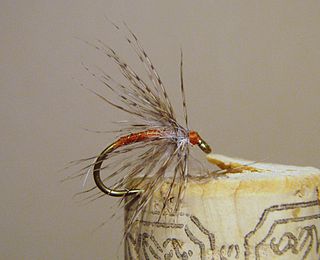
The Partridge and Orange is an artificial fly commonly categorized as a wet fly or soft hackle and is fished under the water surface. The fly is a very well known fly with its roots set firmly in English angling history. It is an impressionistic pattern fished successfully during caddis hatches and spinner falls. The Partridge and Orange is traditionally a trout and grayling pattern but may be used for other aquatic insect feeding species.

The Royal Coachman is an artificial fly that has been tied as a wet fly, dry fly and streamer pattern. Today, the Royal Coachman and its variations are tied mostly as dry flies and fished floating on the water surface. It is a popular and widely used pattern for freshwater game fish, particularly trout and grayling. Large streamer versions are also used for winter steelhead and Atlantic salmon.
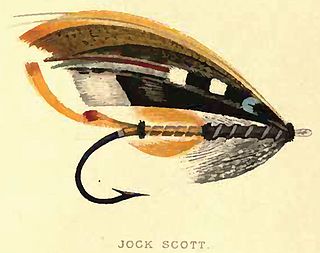
Fully dressed flies are elaborate and colorful artificial flies used in fly fishing. The most famous of these are the classic salmon flies, which are exquisite patterns made from mostly rare and beautiful materials and feathers, including golden pheasants, toucans, swans, and ivory-billed woodpeckers. These flies have been popular in the United Kingdom since the 19th century. Fully dressed flies are often meant for display and are not used in actual fishing. Many patterns are expensive to tie because of the cost of rare feathers.

This annotated bibliography is intended to list both notable and not so notable works of English language, non-fiction and fiction related to the sport of fly fishing listed by year published. Although 100% of any book listed is not necessarily devoted to fly fishing, all these titles have significant fly fishing content. Included in this bibliography is a list of fly tying, fly tackle, regional guides, memoirs, stories and fly fishing fiction related literature.

The Royal Wulff is a popular artificial fly used for dry fly fishing. It is an attractor pattern and a descendant of both the Royal Coachman fly and the Wulff style of hair wing flies named for Lee Wulff.
Carrie Gertrude Stevens (1882-1970) was an American fly fisher and fly lure tier from Madison and Upper Dam, Maine, and the creator of Rangeley Favorite trout and salmon flies. Self-taught in the art of fly tying, Stevens invented the Grey Ghost Streamer, an imitation of the Smelt, Osmerus mordax. Stevens' flies received national and international acclaim, and she was honored after her death with the naming of August 15, 1970 as "Carrie Gertrude Stevens Day" by the Governor of Maine.
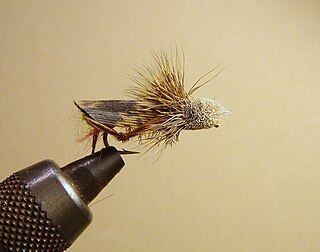
Dave's Hopper is an artificial fly used for fly fishing, designed to imitate adult grasshoppers and other Orthoptera species. It is considered a dry fly terrestrial pattern. It was designed by fly tyer and angler Dave Whitlock, and combines the best aspects of Joe's Hopper and Muddler Minnow patterns.
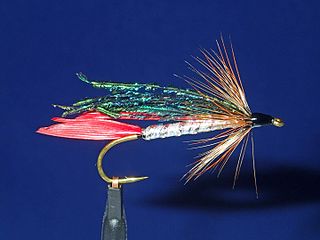
The Alexandra wet fly originated in Scotland in the 1860s. The artificial fly is also known as the Lady of the Lake, the fly was named by English angler Major William Greer Turle to honor Alexandra, Princess of Wales. The fly is distinguished by the heavy peacock herl wing and silver body which makes the fly resemble a small baitfish or fry. The Alexandra proved to be a very effective fly for trout in lakes and streams in England and Scotland in the late 19th and early 20th century. Many fly fishing purists derided the fly and its use was once banned on many English waters.

The Red Tag is an artificial fly originally designed as a dry fly for grayling and trout in the north country of England. The fly pattern, when introduced into Australia, particularly Tasmania, became extremely successful and popular for brown trout and remains today as one of the most essential flies for Australian fly anglers.

The Wulff series of dry flies evolved from a dry fly style conceived by angler Lee Wulff in the 1930s.
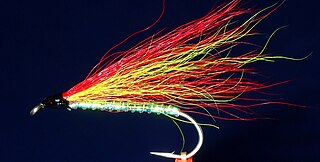
The Mickey Finn is a historic and effective bucktail streamer used by fly anglers for trout, warm-water and saltwater species. The fly is somewhat generic and imitates a wide variety of baitfish. Although most likely originated in the late 19th century by Eastern Canadian anglers, the Mickey Finn pattern once known as the Red and yellow bucktail was popularized by angler and author John Alden Knight in 1937.

Terrestrial flies are a broad group of artificial flies used by fly anglers to imitate terrestrial insects that fall prey to fish in rivers, streams and lakes. Most typical are patterns imitating grasshoppers, crickets, ants, beetles, leaf hoppers, cicadas and moths.






















